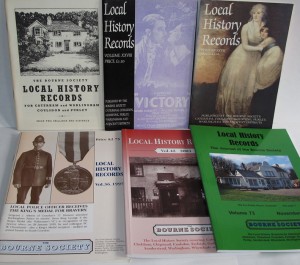 All Bourne Society members regularly receive a copy of the Society’s journal known as the Local History Records (LHR). The journal is packed with short articles of interest to the local historian as well as items of news, forthcoming events, recent group activities, contact details, and so on.
All Bourne Society members regularly receive a copy of the Society’s journal known as the Local History Records (LHR). The journal is packed with short articles of interest to the local historian as well as items of news, forthcoming events, recent group activities, contact details, and so on.
This booklet, which typically runs to 70 or 80 pages, has a long and illustrious history. From 1956 to 2006 the Bourne Society published a newsletter, The Bourne Society Bulletin, which at first appeared irregularly before settling into a quarterly publication, amassing 202 issues. Of these, the first 140 issues were duplicated on separate foolscap or A4 sheets, stapled at the corner. Issues 141 to 202 were printed as staple-bound A5 booklets, typically containing around 30 to 60 pages, with issues 179 to 202 having a picture on the front cover.
In 1962, six years after its foundation, the Society also began publication of an annual Local History Records. While copies of the Bulletin were circulated only to members, issues of the LHR could, in addition, be purchased by the general public at participating local shops. Such was the demand for the first five issues of LHR that they were often reprinted, volume 1 as many as three times over ten years. (The reprint number and date can be found on the back cover.) Volume 45, issued for 2006 and published in November 2005, was a special Jubilee Edition, celebrating the Society’s fiftieth anniversary.
 Late in 2005 the Society’s council decided that the two publications should be merged into a new quarterly Local History Records, incorporating the Bourne Society Bulletin. The numbering sequence of Local History Records was retained, and the first volume of the new combined publication, number 46, appeared in February 2006. From 1962 to 2017 issues of Local History Records were published quarterly, with line drawings or photographs in monochrome. However, in August 2017 (volume 92) the journal was issued experimentally for the first time with images in colour, or in the original sepia if applicable. This proved popular with members, and after consultation the decision was made to produce all future issues in colour while reducing their frequency to three times per year. This was necessary in order to offset the increased cost without needing to raise the annual subscription. Hence, volume 93, November 2017, became the last of the quarterly issues. The ISSN of all Local History Record volumes is 0520-6790.
Late in 2005 the Society’s council decided that the two publications should be merged into a new quarterly Local History Records, incorporating the Bourne Society Bulletin. The numbering sequence of Local History Records was retained, and the first volume of the new combined publication, number 46, appeared in February 2006. From 1962 to 2017 issues of Local History Records were published quarterly, with line drawings or photographs in monochrome. However, in August 2017 (volume 92) the journal was issued experimentally for the first time with images in colour, or in the original sepia if applicable. This proved popular with members, and after consultation the decision was made to produce all future issues in colour while reducing their frequency to three times per year. This was necessary in order to offset the increased cost without needing to raise the annual subscription. Hence, volume 93, November 2017, became the last of the quarterly issues. The ISSN of all Local History Record volumes is 0520-6790.
Back numbers of nearly all issues of Local History Records are still available through GENfair (see Society Shop) at prices varying between 90p and £5, depending on date. Postage and packing is £1.50 per book. Out-of-print issues are available as downloadable eBooks. Alternatively, sale copies may be found in the East Surrey Museum (please ask a steward).
Copies of the Bulletin are more elusive but single issues (other than the earliest typed sheets) might still be available by personal request from the Publications Subcommittee (see the Contact Us page). At present, and until stocks run out, the East Surrey Museum has several collections of Bulletins and LHRs which have been kindly donated for sale by friends of the museum (please ask a steward). Alternatively, full sets of both the Bulletin and LHR may be consulted at the Caterham Valley Public Library and in the East Surrey Museum, both of them in Stafford Road, Caterham.
Information for prospective Authors
Contributions to Local History Records are always welcome and must be sent to the editor, Ray Howgego, whose contact details are given on the inside title page of every LHR. Submissions are acceptable in any format, including handwritten manuscript, typescript and electronic files. Oral (spoken word) histories and recollections are especially valued, for which the Society can organise personal interviews or recordings.
Don’t be put off if you’ve never written an article before, don’t know how to get started, or are concerned that your English is not good enough. The editor can provide help at every step of the way.